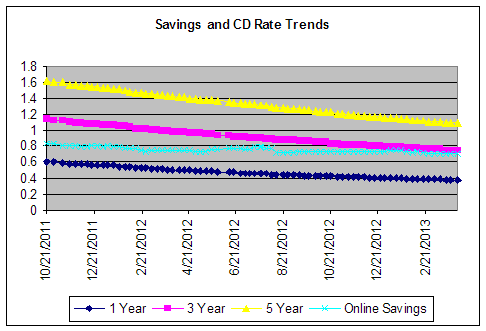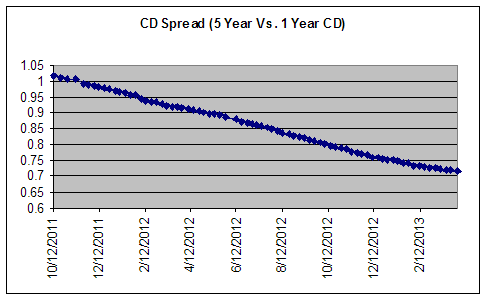I went on vacation last week and was driving down to Washington D.C. when news reached me of the Boston Marathon bombing. I grew up and live in Boston and have been at the finish line many times, so the news of the attack came as a shock. Sad. In Washington, we visited the Capitol and when officials asked where we were from and heard Boston, they'd nod their heads and express sympathy. It was a tough week and not one focused on financial events.
I had hoped that when I came back that rates would have done someting surprising, maybe a positive move to counteract the negative events in Boston. But no, the downward trend continues. CD rates declined last week for the 79th straight week. Average one-year CD Rates dipped from 0.373% to 0.371% APY. Three year average CD rates dropped from 0.738% to .734% APY. Five year average CDs dropped to from 1.081% to 1.075% APY. The one bright spot, online savings account rates even dipped a bit, falling from 0.707% to 0.705% APY. We remain on pace to see a sub-1% average APY on a 5 year CD rate by August or September.
Even if the averages are all below 1%, the top rates are still significantly higher. BestCashCow data shows the top rates for some key terms are:
- Online Savings: AmTrust Direct retained the top spot at 1.05% APY.
- 1 Year CD: Three banks retain the top spot at 1.05% APY.
- 3 Year CD: Navy Federal Credit Union continues to have the highest rate at 1.40% APY.
- 5 Year CD: Barclays Bank Delaware occupies the top spot alone at 1.85% APY.
- Rewards Checking: Hope Credit Union and Money One Federal Credit Union both have the top rewards checking rate of 3.01% APY for balances up to $10,000. Both credit unions are open to members from across the country.
Local banks and credit unions often offer better rates (especially for CDs) than online banks so be sure to check them out.
The chart below shows the trend in average rates since October 2012.
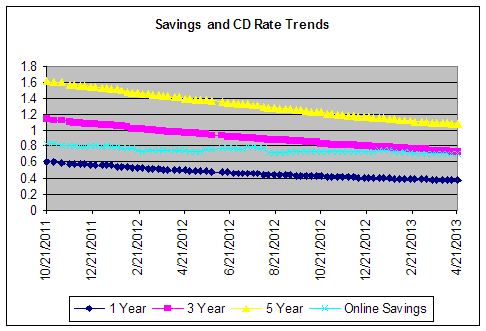
The difference in the rate of decline between online savings and CD rates can be viewed on the chart below, which shows the spread between online savings account rates and 12 month CDs. On average, online savings account rates pay 0.334 percentage points more than 1 year CDs, up from 0.23 percentage points more at the beginning of last year but down from the spread's high of 0.344 percentage points in late January.
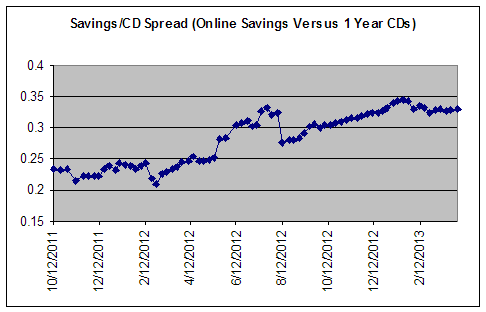
General rate environment
Bloomberg had an article on the timing of a rate hike with most economists believing it won't happen until 2015. Bottom line is that until unemployment comes down further, we're stuck in a low rate environment.
The National Association of Realtors reported on March existing home sales and the news is no real news. Home sales declined 0.6 percent but according to Lawrence Yun, Chief Economist for NAR, that was because there was more demand than supply. He stated that:
"Buyer traffic is 25 percent above a year ago when we were already seeing notable gains in shopping activity. In the same timeframe housing inventories have trended much lower, which is continuing to pressure home prices. The good news is home construction is rising and low mortgage rates are continuing to keep affordability conditions at historically favorable levels. The bad news is that underwriting standards remain excessively tight, while renters are getting squeezed by higher rents."
Bottom line: housing continues to improve but no big gains.
My outlook: Savings rates will continue to drift lower for the next 8-14 months before beginning to move higher. How high and how fast they move will depend on the level of local, state, and federal taxes and cuts; the continuation of a recent economic uptick; technological advances; and the ability of Europe to put its woes behind it and resolve its fiscal problems.
Savings Accounts or CDs?
The data continues to show that opening a savings account is a better bet than a 1-3 year term CD and I expect this to hold through 2013. Online savings accounts have held the line over the past year while CD rates continue to fall. As the chart shows, the premium for opening a longer-term CD has eroded significantly and continuously over the past year. While the premium for opening a 5 year CD over a 1 year CD was 1 percentage point in October 2011, it now stands at .704 percentage points.
Is it worth it to go long and open a 5 year? If you don't need the money, it's probably okay. Rates may begin to rise in the next year but they probably won't shoot up. Inflation looks to remain tame. There is also the chance that we go Japanese and rates continue to decline, bottom out, and stay low for the next 5-10 years. In that case, a 5-year CD today would look good. I don't expect that to happen, but it could.
For money you want to keep liquid, go with online savings accounts. They offer better rates than 1-3 year CDs and athough several banks have dropped rates in the past month, they have still offered decent rate stability over the past year and a half.
If you want to take advantage of the higher rates on longer-term CDs, look to open them at local community banks. BestCashCow research has shown that community banks and credit unions offer the most competitive rates on longer-maturity CDs. Otherwise, you'd be better off keeping your money liquid in an online savings account.
I believe this is the best and easiest strategy for keeping your cash liquid and maximizing your savings over the next year.
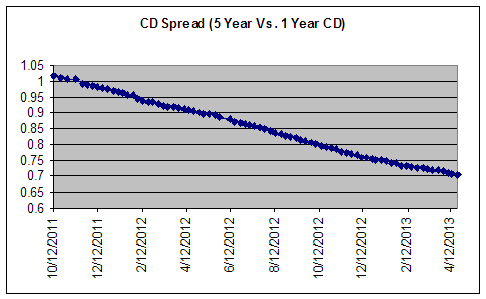
Make the best of a tough savings situation in 2013
Yields may be low in 2013 but a savvy saver can boost the return with no increase in rate by rate shopping. By shopping around, a saver can earn an extra half to full percentage point. On $100,000, that's $1,000 in extra cash per year. Remember, even in today's environment, there is competition for your cash.

